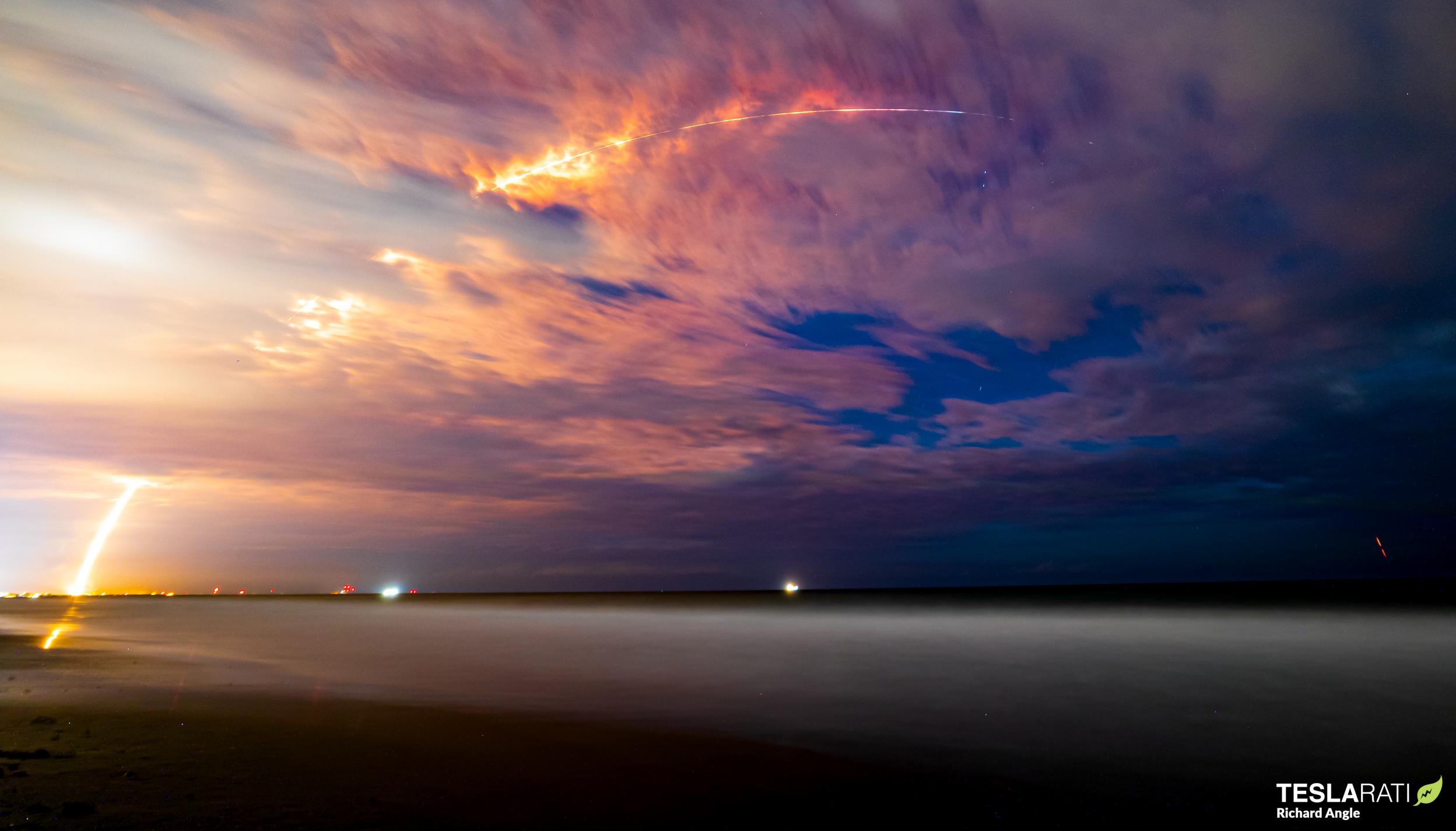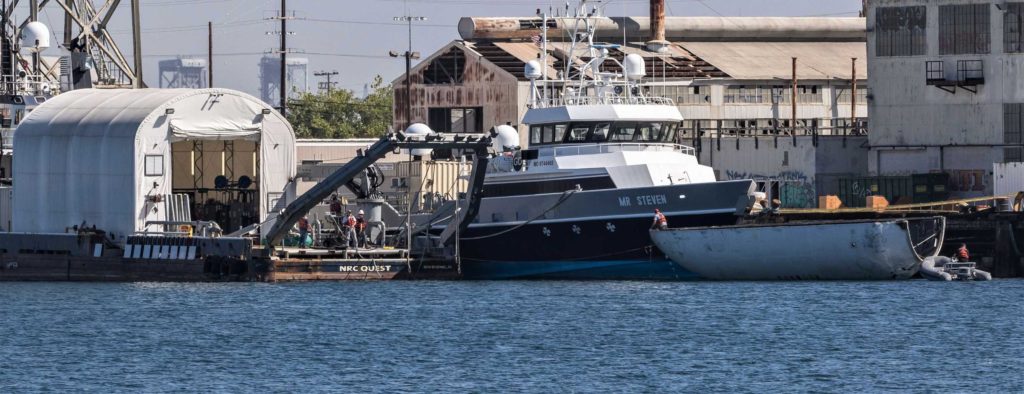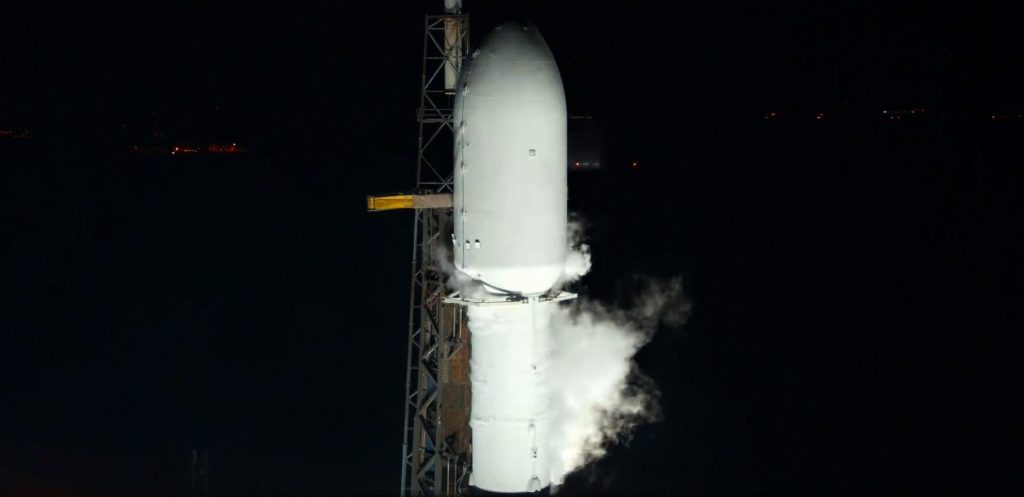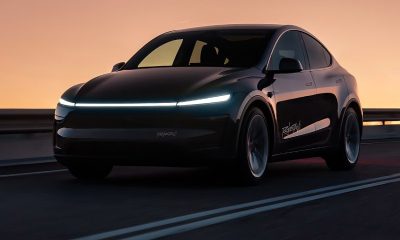

News
SpaceX Falcon 9 rocket completes 50th orbital launch of 2022
SpaceX has successfully launched French satellite communications provider Eutelsat’s Hotbird 13G satellite, chipping away at a jam-packed November manifest and completing Falcon 9’s 50th launch of 2022.
The company’s workhorse rocket lifted off from its Cape Canaveral Space Force Station (CCSFS) LC-40 pad with the 4.5-ton (~9,900 lb) geostationary communications satellite in tow at 1:22 am EDT on November 3rd – 116 minutes later than originally planned to leave more time “to complete pre-flight checkouts.” But Falcon 9 performed flawlessly, growing a record-breaking streak with its 160th consecutively-successful launch.
Flying for the seventh time since it debuted in June 2021 and just 45 days after its sixth flight, Falcon 9 booster B1067 completed a nominal ascent, separation, descent, reentry, and landing. The booster touched down on SpaceX drone ship Just Read The Instructions (JRTI) about nine minutes after liftoff and will be prepared for an eighth launch in the near future – possibly as early as next month. In addition to its well-known booster reuse, SpaceX’s webcast host noted that Falcon 9’s payload fairing – a carbon fiber composite nosecone made up of two separable halves – had halves flying for the fourth and sixth time.
Speaking in 2017, SpaceX CEO Elon Musk once likened each Falcon fairing half to a pallet of $3 million that falls into the ocean after every launch. Around the same time, SpaceX decided to try to recover that pallet of cash, kicking off its fairing recovery and reuse program. Five years later, Falcon fairing reuse – while far less visible and famous than booster reuse – has become extremely reliable. At its current rate of one launch every six days, recovering and reusing fairings likely saves SpaceX tens or even hundreds of millions of dollars annually and limits the need for major manufacturing expansions that would otherwise be necessary.
Even though SpaceX fishes fairing halves out of the ocean before every flight, the company’s cleaning and refurbishment processes have improved to the point that even paying customers have started to accept flight-proven fairings on their launches. Eutelsat’s Hotbird 13G satellite is the first customer payload to use a Falcon fairing half for the sixth time, further raising the bar of acceptance.


About half an hour after liftoff, Falcon 9’s expendable upper stage separated from Hotbird 13G. On October 15th, a different Falcon 9 rocket launched its twin, Hotbird 13F, into a supersynchronous transfer orbit measuring around 400 kilometers (~245 mi) by 56,000 kilometers (~34,800 mi). Launching a satellite to a transfer orbit with an apogee higher than its destination makes reaching a circular orbit at that target altitude (35,800 km, in this case) faster and easier. Having to do less work to raise its orbit will leave Hotbird 13F and 13G with more fuel than they would otherwise have, effectively extending their theoretical lifespans by preserving more propellant for orbit maintenance after it reaches GEO.
Hotbird 13G was SpaceX’s 51st launch of 2022 and 59th launch in 365 days. If SpaceX sustains the average pace it has set in the last ten months through the last two months of 2022, it could end the year having launched more than 60 times. The mission was also Falcon 9’s 50th launch of 2022, solidifying its spot as the most-launched rocket in a calendar year. The record for the most successful launches (61) of the same rocket family in one year, however, was set by the Soviet Union and has stood for more than four decades.
SpaceX has at least five more Falcon 9 launches tentatively scheduled this month. Intelsat Galaxy 31 & 32 satellites are up next and could launch from the same pad as Hotbird 13G as early as November 8th, followed by Eutelsat 10B in mid-November, and Japanese startup ispace’s first Moon lander no earlier than November 22nd. An uncrewed Dragon spacecraft is set to launch NASA cargo to the the International Space Station (ISS) on November 20th. Finally, while tentative and contingent upon three other launches going smoothly, SpaceX could squeeze in Starlink 4-37 in late November.
News
Tesla UK sales see 14% year-over-year rebound in June: SMMT data
The SMMT stated that Tesla sales grew 14% year-over-year to 7,719 units in June 2025.

Tesla’s sales in the United Kingdom rose in June, climbing 14% year-over-year to 7,719 units, as per data from the Society of Motor Manufacturers and Traders (SMMT). The spike in the company’s sales coincided with the first deliveries of the updated Model Y last month.
Model Y deliveries support Tesla’s UK recovery
Tesla’s June performance marked one of its strongest months in the UK so far this year, with new Model Y deliveries contributing significantly to the company’s momentum.
While the SMMT listed Tesla with 7,719 deliveries in June, independent data from New AutoMotive suggested that the electric vehicle maker registered 7,891 units during the month instead. However, year-to-date figures for Tesla remain 2% down compared to 2024, as per a report from Reuters.
While Tesla made a strong showing in June, rivals are also growing. Chinese automaker BYD saw UK sales rise nearly fourfold to 2,498 units, while Ford posted the highest EV growth among major automakers, with a more than fourfold increase in the first half of 2025.
Overall, the UK’s battery electric vehicle (BEV) demand surged 39% to to 47,354 units last month, helping push total new car sales in the UK to 191,316 units, up 6.7% from the same period in 2024.
EV adoption accelerates, but concerns linger
June marked the best month for UK car sales since 2019, though the SMMT cautioned that growth in the electric vehicle sector remains heavily dependent on discounting and support programs. Still, one in four new vehicle buyers in June chose a battery electric vehicle.
SMMT Chief Executive Mike Hawes noted that despite strong BEV demand, sales levels are still below regulatory targets. “Further growth in sales, and the sector will rely on increased and improved charging facilities to boost mainstream electric vehicle adoption,” Hawes stated.
Also taking effect this week was a new US-UK trade deal, which lowers tariffs on UK car exports to the United States from 27.5% to 10%. The agreement could benefit UK-based EV producers aiming to expand across the country.
News
Tesla Model 3 ranks as the safest new car in Europe for 2025, per Euro NCAP tests
Despite being on the market longer than many of its rivals, the Tesla Model 3 continues to set the bar for vehicle safety.

The Tesla Model 3 has been named the safest new car on sale in 2025, according to the latest results from the Euro NCAP. Among 20 newly tested vehicles, the Model 3 emerged at the top of the list, scoring an impressive 359 out of 400 possible points across all major safety categories.
Tesla Model 3’s safety systems
Despite being on the market longer than many of its rivals, the Tesla Model 3 continues to set the bar for vehicle safety. Under Euro NCAP’s stricter 2025 testing protocols, the electric sedan earned 90% for adult occupant protection, 93% for child occupant protection, 89% for pedestrian protection, and 87% for its Safety Assist systems.
The updated Model 3 received particular praise for its advanced driver assistance features, including Tesla’s autonomous emergency braking (AEB) system, which performed well across various test scenarios. Its Intelligent Speed Assistance and child presence detection system were cited as noteworthy features as well, as per a WhatCar report.
Other notable safety features include the Model 3’s pedestrian-friendly pop-up hood and robust crash protection for both front and side collisions. Euro NCAP also highlighted the Model 3’s ability to detect vulnerable road users during complex maneuvers, such as turning across oncoming traffic.
Euro NCAP’s Autopilot caution
While the Model 3’s safety scores were impressive across the board, Euro NCAP did raise concerns about driver expectations of Tesla’s Autopilot system. The organization warned that some owners may overestimate the system’s capabilities, potentially leading to misuse or inattention behind the wheel. Even so, the Model 3 remained the highest-scoring vehicle tested under Euro NCAP’s updated criteria this year.
The Euro NCAP’s concerns are also quite interesting because Tesla’s Full Self-Driving (FSD) Supervised, which is arguably the company’s most robust safety suite, is not allowed for public rollout in Europe yet. FSD Supervised would allow the Model 3 to navigate inner city streets with only minimal human supervision.
Other top scorers included the Volkswagen ID.7, Polestar 3, and Geely EX5, but none matched the Model 3’s total score or consistency across categories. A total of 14 out of 20 newly tested cars earned five stars, while several models, including the Kia EV3, MG ZS, and Renault 5, fell short of the top rating.
Elon Musk
Why Tesla’s Q3 could be one of its biggest quarters in history
Tesla could stand to benefit from the removal of the $7,500 EV tax credit at the end of Q3.

Tesla has gotten off to a slow start in 2025, as the first half of the year has not been one to remember from a delivery perspective.
However, Q3 could end up being one of the best the company has had in history, with the United States potentially being a major contributor to what might reverse a slow start to the year.
Earlier today, the United States’ House of Representatives officially passed President Trump’s “Big Beautiful Bill,” after it made its way through the Senate earlier this week. The bill will head to President Trump, as he looks to sign it before his July 4 deadline.
The Bill will effectively bring closure to the $7,500 EV tax credit, which will end on September 30, 2025. This means, over the next three months in the United States, those who are looking to buy an EV will have their last chance to take advantage of the credit. EVs will then be, for most people, $7,500 more expensive, in essence.
The tax credit is available to any single filer who makes under $150,000 per year, $225,000 a year to a head of household, and $300,000 to couples filing jointly.
Ending the tax credit was expected with the Trump administration, as his policies have leaned significantly toward reliance on fossil fuels, ending what he calls an “EV mandate.” He has used this phrase several times in disagreements with Tesla CEO Elon Musk.
Nevertheless, those who have been on the fence about buying a Tesla, or any EV, for that matter, will have some decisions to make in the next three months. While all companies will stand to benefit from this time crunch, Tesla could be the true winner because of its sheer volume.
If things are done correctly, meaning if Tesla can also offer incentives like 0% APR, special pricing on leasing or financing, or other advantages (like free Red, White, and Blue for a short period of time in celebration of Independence Day), it could see some real volume in sales this quarter.
You can now buy a Tesla in Red, White, and Blue for free until July 14 https://t.co/iAwhaRFOH0
— TESLARATI (@Teslarati) July 3, 2025
Tesla is just a shade under 721,000 deliveries for the year, so it’s on pace for roughly 1.4 million for 2025. This would be a decrease from the 1.8 million cars it delivered in each of the last two years. Traditionally, the second half of the year has produced Tesla’s strongest quarters. Its top three quarters in terms of deliveries are Q4 2024 with 495,570 vehicles, Q4 2023 with 484,507 vehicles, and Q3 2024 with 462,890 vehicles.
-

 Elon Musk6 days ago
Elon Musk6 days agoTesla investors will be shocked by Jim Cramer’s latest assessment
-

 News2 weeks ago
News2 weeks agoTesla Robotaxi’s biggest challenge seems to be this one thing
-

 Elon Musk2 weeks ago
Elon Musk2 weeks agoFirst Look at Tesla’s Robotaxi App: features, design, and more
-

 News2 weeks ago
News2 weeks agoWatch Tesla’s first driverless public Robotaxi rides in Texas
-

 News2 weeks ago
News2 weeks agoWatch the first true Tesla Robotaxi intervention by safety monitor
-

 Elon Musk2 weeks ago
Elon Musk2 weeks agoTesla officially launches Robotaxi service with no driver
-

 Elon Musk1 week ago
Elon Musk1 week agoA Tesla just delivered itself to a customer autonomously, Elon Musk confirms
-

 News2 weeks ago
News2 weeks agoTesla Robotaxi rollout proves that Elon Musk still delivers, even if it’s late




















